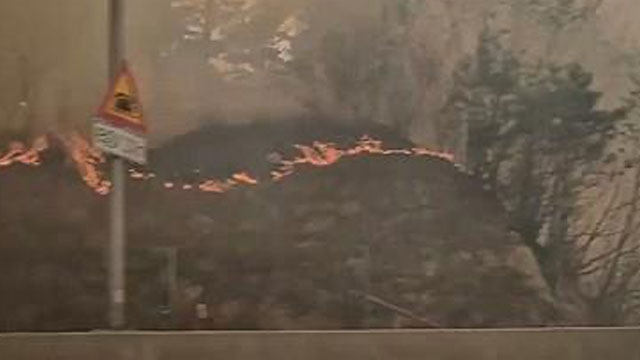Authorities reject shorter runway length of Muan Airport as cause of tragedy
입력 2024.12.30 (01:23)
읽어주기 기능은 크롬기반의
브라우저에서만 사용하실 수 있습니다.
[Anchor]
Relatively small passenger aircraft is operated out of Muan Airport.
Because of this, the runway is shorter compared to larger airports.
There are speculations that if the runway had been a bit longer, the tragedy could have been avoided.
This is Lee Kwang-yeol reporting.
[Report]
The runway length at Muan Airport, where the accident occurred, is 2.8 km.
In comparison, Incheon Airport has a runway of 3.7 km, and Gimpo Airport has 3.6 km, making Muan's runway about 800 to 900 meters shorter.
Due to this, from the early stages of the accident, there have been criticism that if the runway had been a bit longer, the aircraft could have had more time to stop during its belly landing.
However, the government has stated that the possibility of the short runway being the cause of the accident is low.
[Joo Jong-wan/Director of Aviation Policy, Ministry of Land, Infrastructure and Transport: "It was an airport where aircraft have been operating previously. Therefore, I think it is difficult to say that the accident occurred because the runway length was insufficient."]
Muan Airport is an airport where relatively small passenger planes operate, making a runway length of over 2.5 km to be sufficient.
However, to expand airport functions, there was a project underway to extend the runway to 3.16 km, aiming for completion next year.
Some argue that it might have been better to attempt a belly landing in the West Sea instead.
In fact, in 2018, a Papua New Guinea Airlines aircraft made an emergency landing in the sea in the South Pacific, avoiding casualties.
However, there is no guarantee that landing in the sea is safer than landing on land.
[Hwang Ho-won/President of the Aviation Security Association: "Aircraft can skid on land. There is no sliding at sea. The degree of sliding naturally has less resistance. So, it can sink. If the speed was low, then it might be possible."]
In response to concerns that the airport's outer wall, which the aircraft collided with, was too close to the runway, the Ministry of Land, Infrastructure and Transport explained that it was constructed in accordance with airport design standards.
This is KBS News, Lee Kwang-yeol.
Relatively small passenger aircraft is operated out of Muan Airport.
Because of this, the runway is shorter compared to larger airports.
There are speculations that if the runway had been a bit longer, the tragedy could have been avoided.
This is Lee Kwang-yeol reporting.
[Report]
The runway length at Muan Airport, where the accident occurred, is 2.8 km.
In comparison, Incheon Airport has a runway of 3.7 km, and Gimpo Airport has 3.6 km, making Muan's runway about 800 to 900 meters shorter.
Due to this, from the early stages of the accident, there have been criticism that if the runway had been a bit longer, the aircraft could have had more time to stop during its belly landing.
However, the government has stated that the possibility of the short runway being the cause of the accident is low.
[Joo Jong-wan/Director of Aviation Policy, Ministry of Land, Infrastructure and Transport: "It was an airport where aircraft have been operating previously. Therefore, I think it is difficult to say that the accident occurred because the runway length was insufficient."]
Muan Airport is an airport where relatively small passenger planes operate, making a runway length of over 2.5 km to be sufficient.
However, to expand airport functions, there was a project underway to extend the runway to 3.16 km, aiming for completion next year.
Some argue that it might have been better to attempt a belly landing in the West Sea instead.
In fact, in 2018, a Papua New Guinea Airlines aircraft made an emergency landing in the sea in the South Pacific, avoiding casualties.
However, there is no guarantee that landing in the sea is safer than landing on land.
[Hwang Ho-won/President of the Aviation Security Association: "Aircraft can skid on land. There is no sliding at sea. The degree of sliding naturally has less resistance. So, it can sink. If the speed was low, then it might be possible."]
In response to concerns that the airport's outer wall, which the aircraft collided with, was too close to the runway, the Ministry of Land, Infrastructure and Transport explained that it was constructed in accordance with airport design standards.
This is KBS News, Lee Kwang-yeol.
■ 제보하기
▷ 카카오톡 : 'KBS제보' 검색, 채널 추가
▷ 전화 : 02-781-1234, 4444
▷ 이메일 : kbs1234@kbs.co.kr
▷ 유튜브, 네이버, 카카오에서도 KBS뉴스를 구독해주세요!
- Authorities reject shorter runway length of Muan Airport as cause of tragedy
-
- 입력 2024-12-30 01:23:25

[Anchor]
Relatively small passenger aircraft is operated out of Muan Airport.
Because of this, the runway is shorter compared to larger airports.
There are speculations that if the runway had been a bit longer, the tragedy could have been avoided.
This is Lee Kwang-yeol reporting.
[Report]
The runway length at Muan Airport, where the accident occurred, is 2.8 km.
In comparison, Incheon Airport has a runway of 3.7 km, and Gimpo Airport has 3.6 km, making Muan's runway about 800 to 900 meters shorter.
Due to this, from the early stages of the accident, there have been criticism that if the runway had been a bit longer, the aircraft could have had more time to stop during its belly landing.
However, the government has stated that the possibility of the short runway being the cause of the accident is low.
[Joo Jong-wan/Director of Aviation Policy, Ministry of Land, Infrastructure and Transport: "It was an airport where aircraft have been operating previously. Therefore, I think it is difficult to say that the accident occurred because the runway length was insufficient."]
Muan Airport is an airport where relatively small passenger planes operate, making a runway length of over 2.5 km to be sufficient.
However, to expand airport functions, there was a project underway to extend the runway to 3.16 km, aiming for completion next year.
Some argue that it might have been better to attempt a belly landing in the West Sea instead.
In fact, in 2018, a Papua New Guinea Airlines aircraft made an emergency landing in the sea in the South Pacific, avoiding casualties.
However, there is no guarantee that landing in the sea is safer than landing on land.
[Hwang Ho-won/President of the Aviation Security Association: "Aircraft can skid on land. There is no sliding at sea. The degree of sliding naturally has less resistance. So, it can sink. If the speed was low, then it might be possible."]
In response to concerns that the airport's outer wall, which the aircraft collided with, was too close to the runway, the Ministry of Land, Infrastructure and Transport explained that it was constructed in accordance with airport design standards.
This is KBS News, Lee Kwang-yeol.
Relatively small passenger aircraft is operated out of Muan Airport.
Because of this, the runway is shorter compared to larger airports.
There are speculations that if the runway had been a bit longer, the tragedy could have been avoided.
This is Lee Kwang-yeol reporting.
[Report]
The runway length at Muan Airport, where the accident occurred, is 2.8 km.
In comparison, Incheon Airport has a runway of 3.7 km, and Gimpo Airport has 3.6 km, making Muan's runway about 800 to 900 meters shorter.
Due to this, from the early stages of the accident, there have been criticism that if the runway had been a bit longer, the aircraft could have had more time to stop during its belly landing.
However, the government has stated that the possibility of the short runway being the cause of the accident is low.
[Joo Jong-wan/Director of Aviation Policy, Ministry of Land, Infrastructure and Transport: "It was an airport where aircraft have been operating previously. Therefore, I think it is difficult to say that the accident occurred because the runway length was insufficient."]
Muan Airport is an airport where relatively small passenger planes operate, making a runway length of over 2.5 km to be sufficient.
However, to expand airport functions, there was a project underway to extend the runway to 3.16 km, aiming for completion next year.
Some argue that it might have been better to attempt a belly landing in the West Sea instead.
In fact, in 2018, a Papua New Guinea Airlines aircraft made an emergency landing in the sea in the South Pacific, avoiding casualties.
However, there is no guarantee that landing in the sea is safer than landing on land.
[Hwang Ho-won/President of the Aviation Security Association: "Aircraft can skid on land. There is no sliding at sea. The degree of sliding naturally has less resistance. So, it can sink. If the speed was low, then it might be possible."]
In response to concerns that the airport's outer wall, which the aircraft collided with, was too close to the runway, the Ministry of Land, Infrastructure and Transport explained that it was constructed in accordance with airport design standards.
This is KBS News, Lee Kwang-yeol.
-
-

이광열 기자 the12th@kbs.co.kr
이광열 기자의 기사 모음
-
이 기사가 좋으셨다면
-
좋아요
0
-
응원해요
0
-
후속 원해요
0










![[속보] 이재명, 민주당 호남 경선서 88.69%로 1위…충청보다 득표율 높아](/data/layer/904/2025/04/20250426_yKnEKN.jpg)




이 기사에 대한 의견을 남겨주세요.